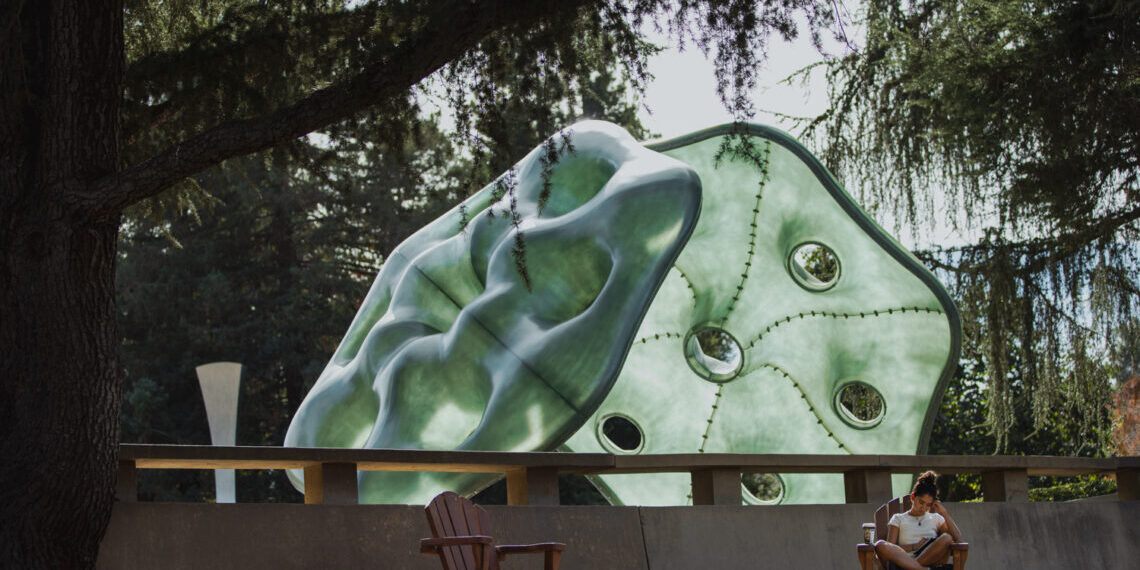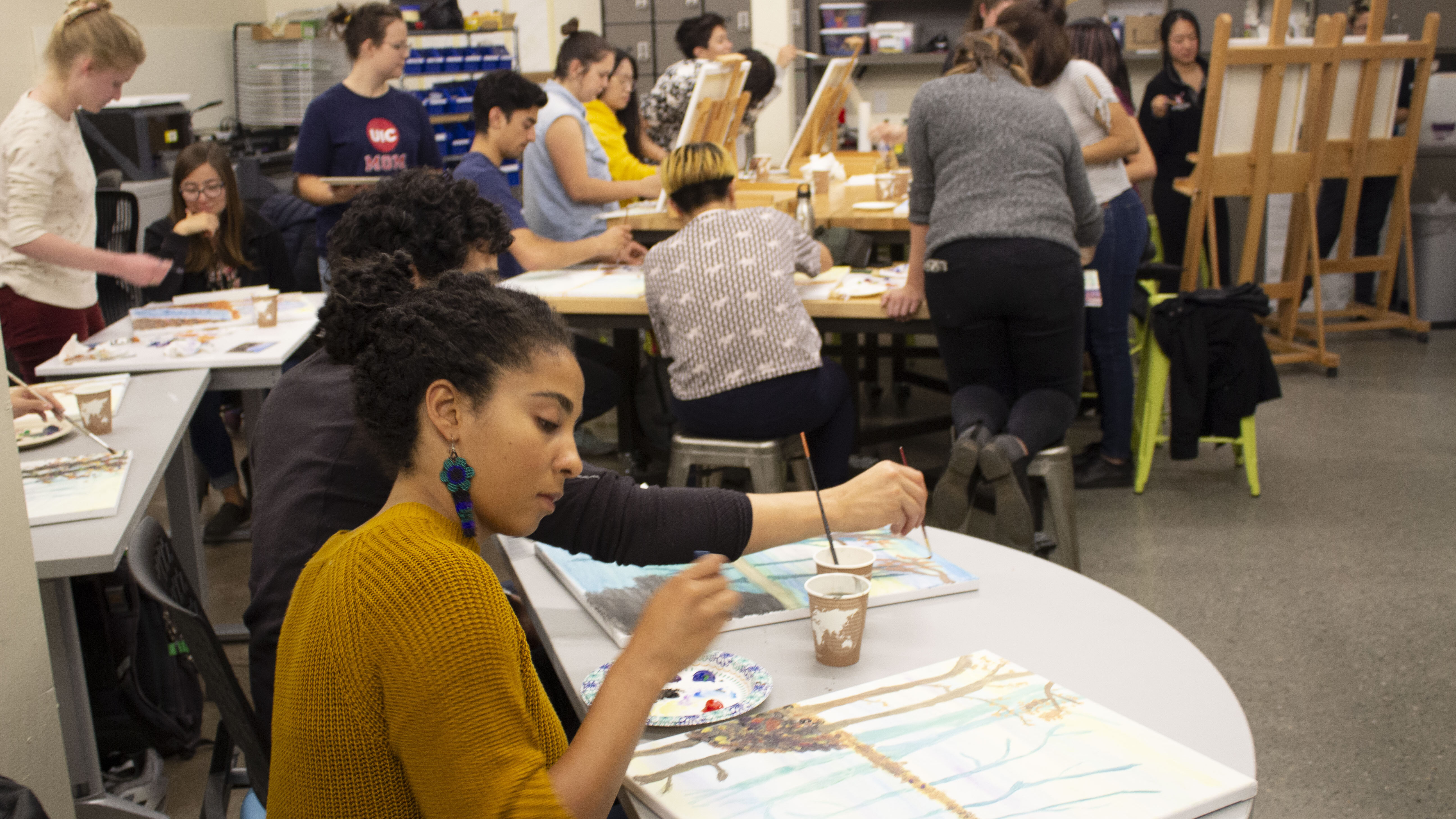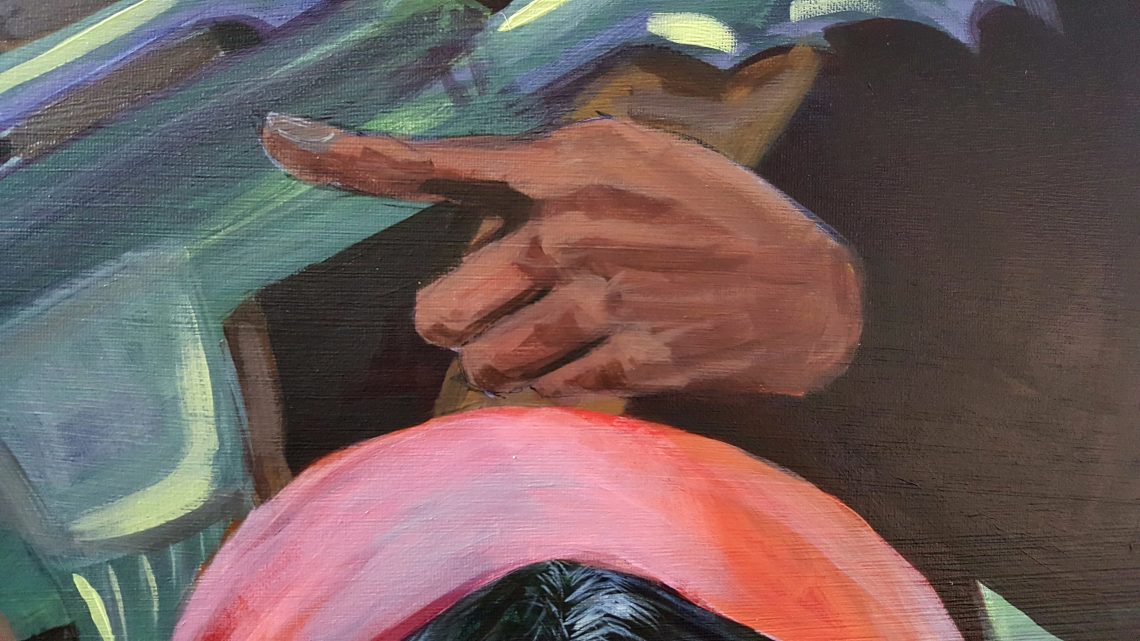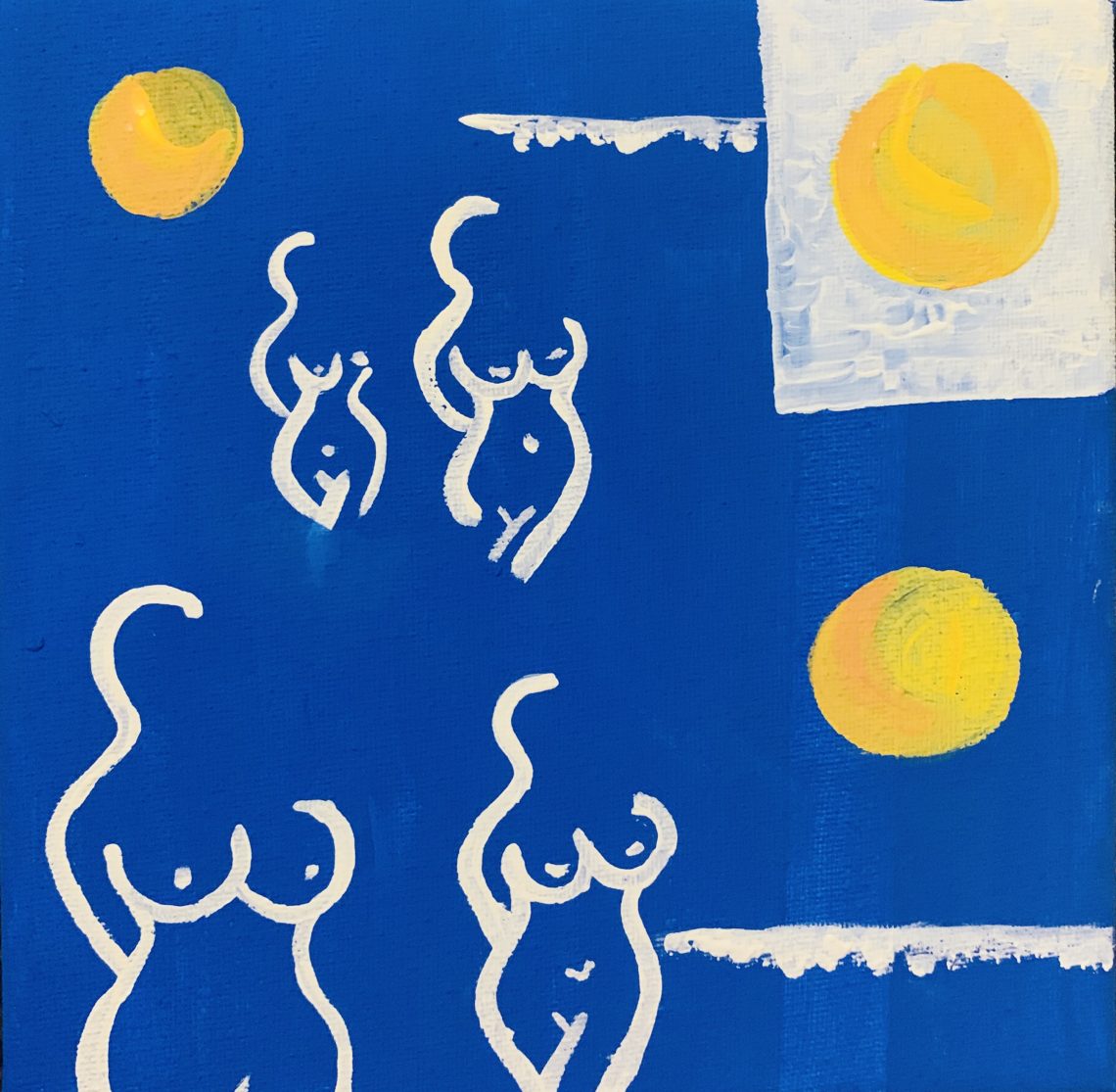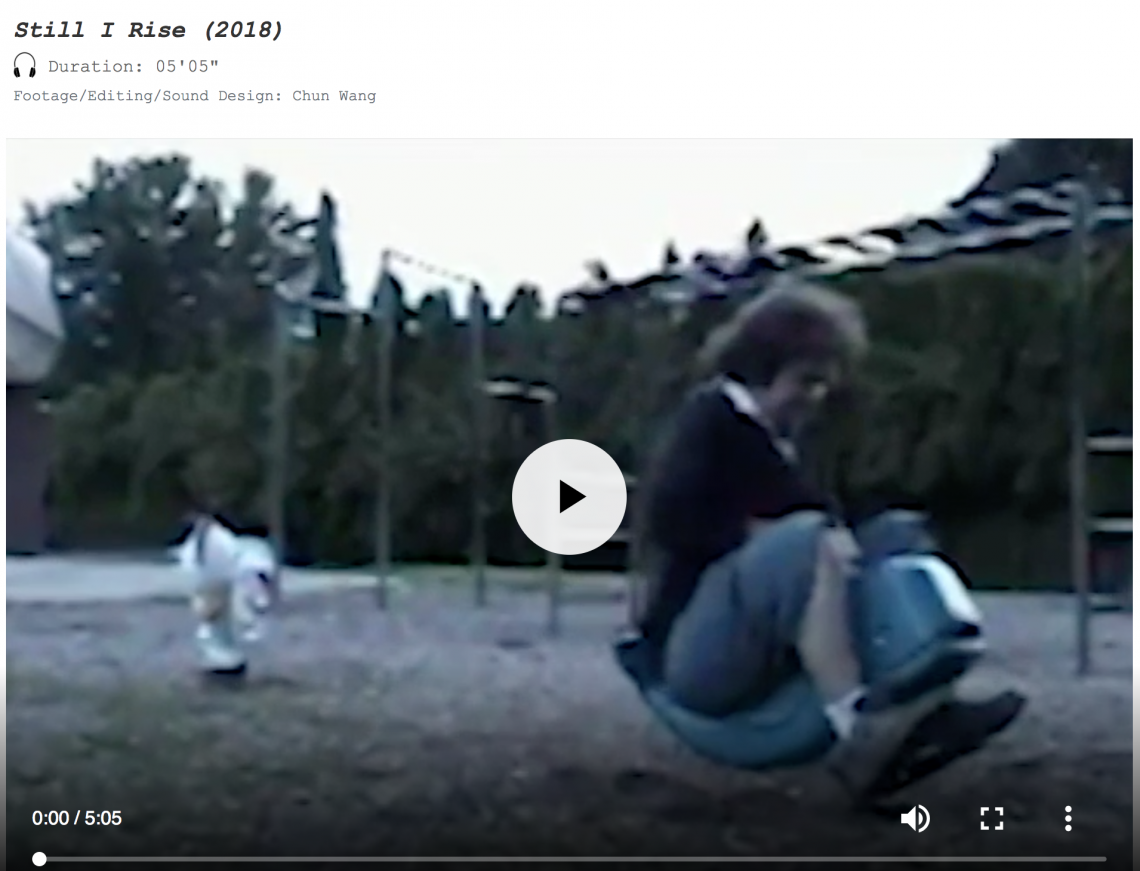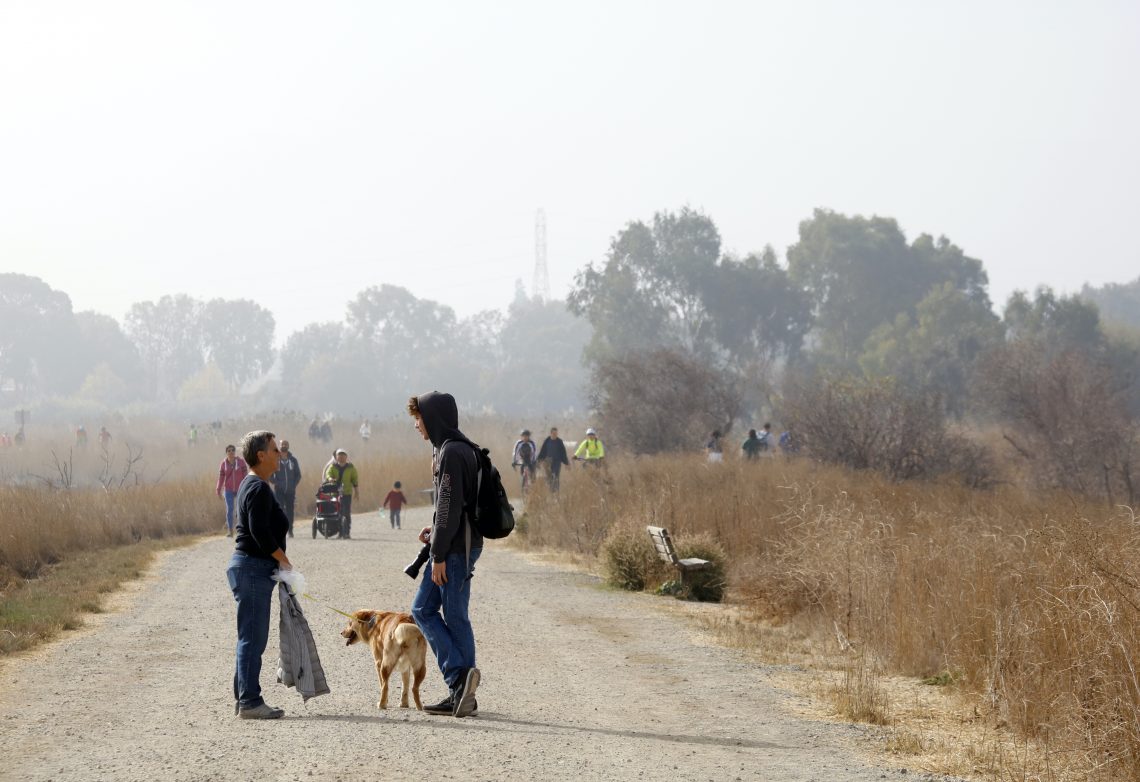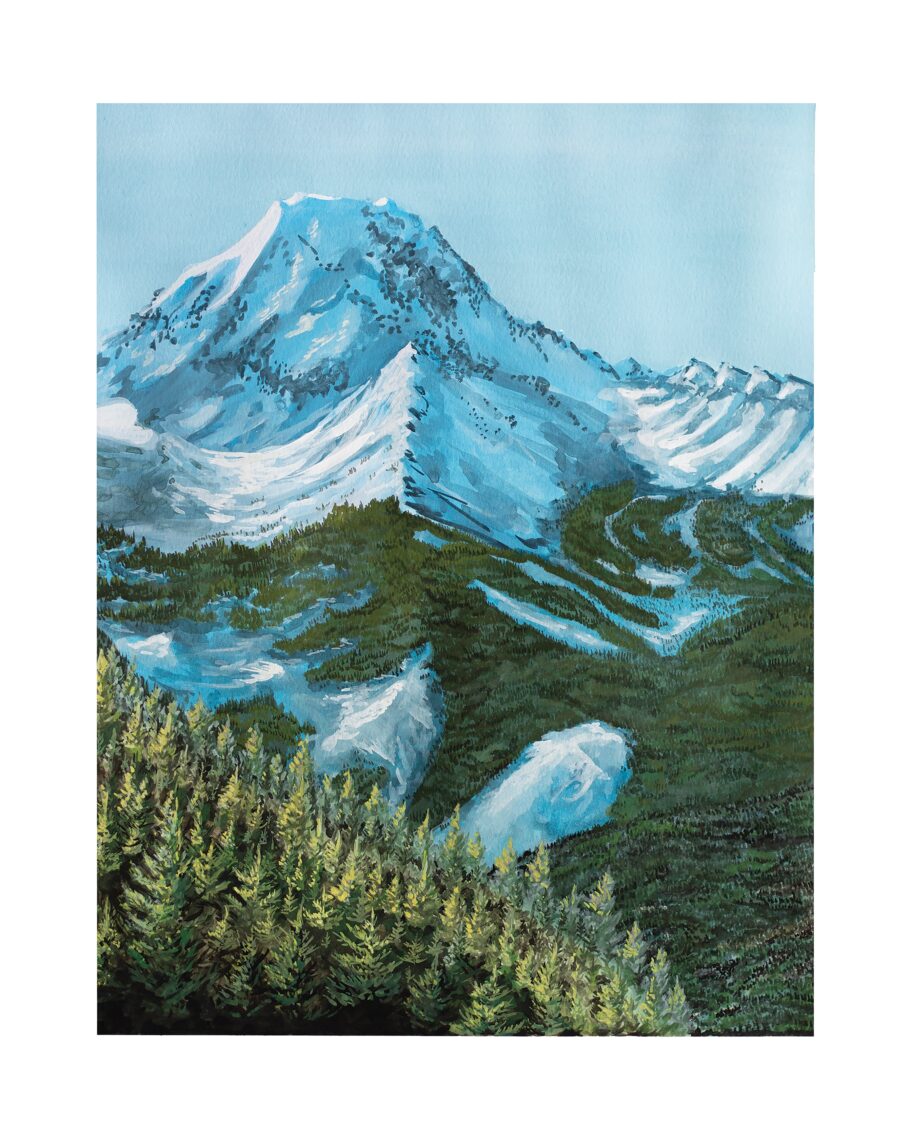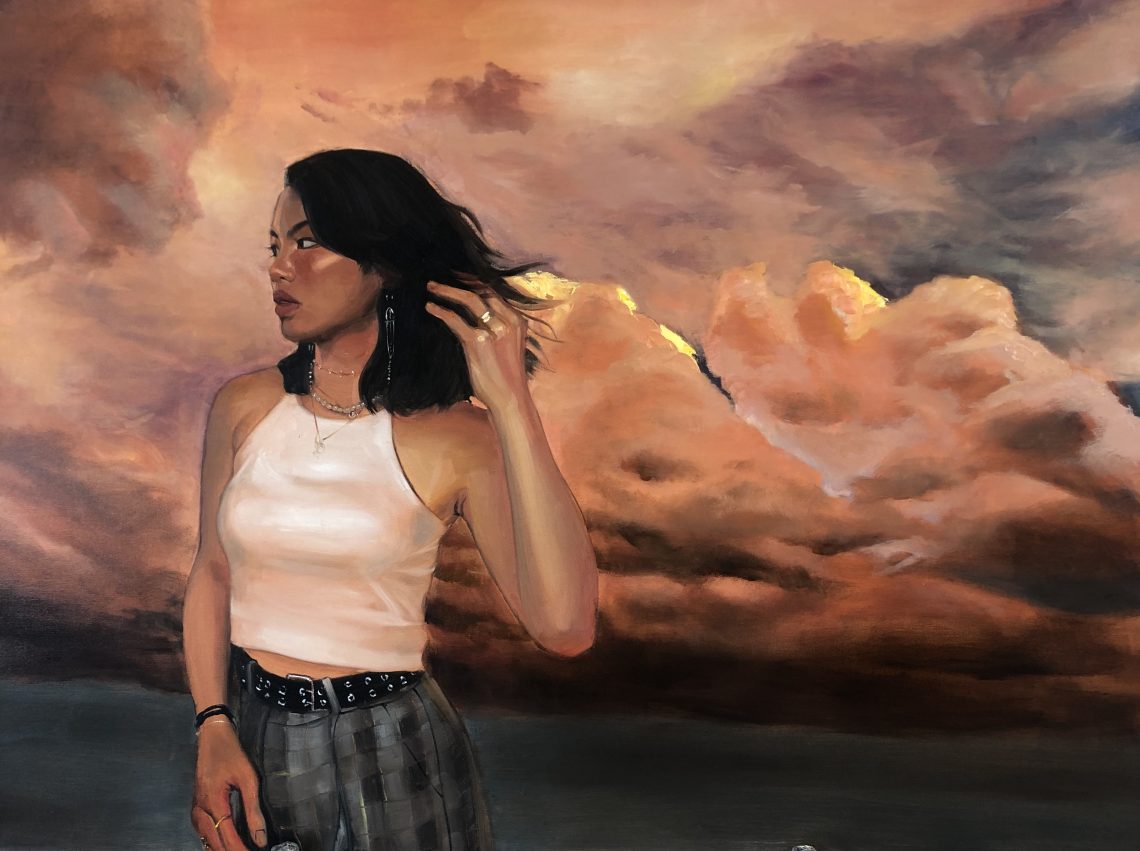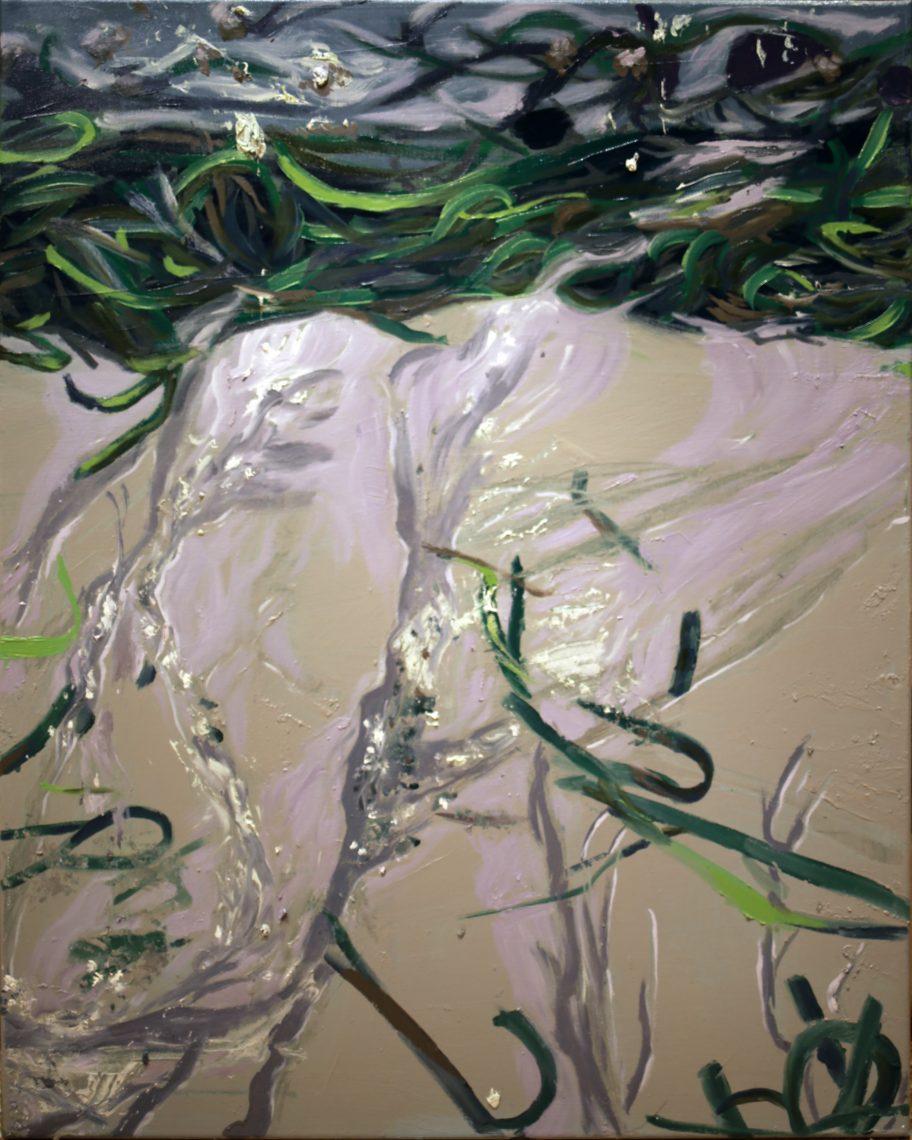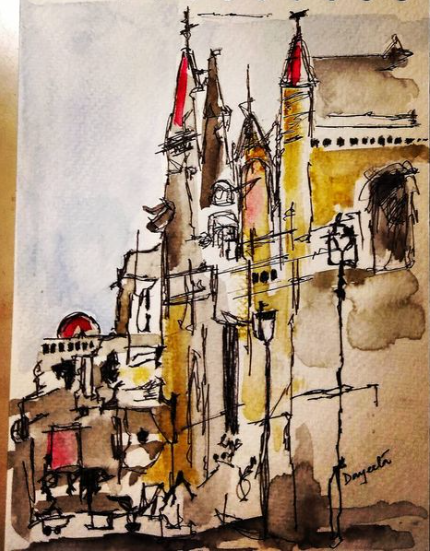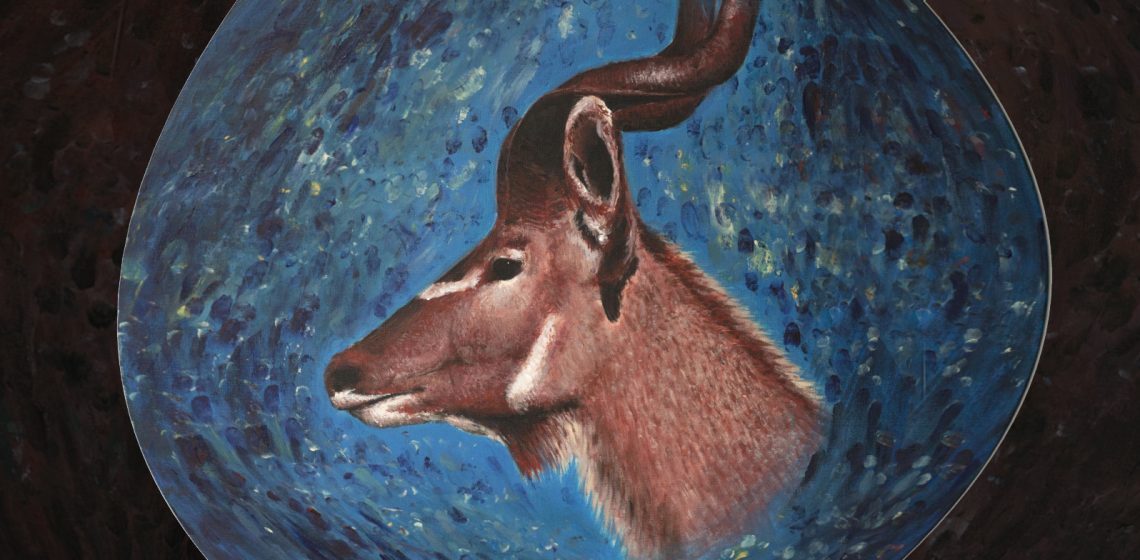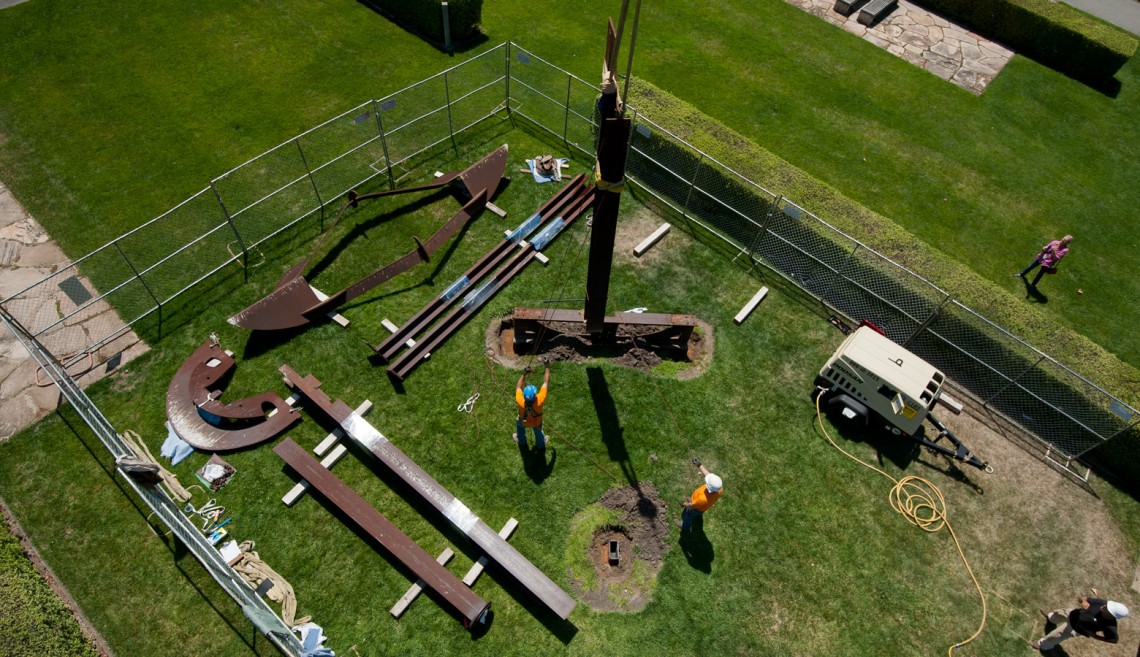
Miwok, Stanford’s monumental outdoor sculpture by di Suvero, moves to a new home
Mark di Suvero's large-scale sculpture settles in on the School of Medicine Dean's Lawn.
Moving art can get complicated very quickly. Frames aren’t always stable, wires fray, pastels and old paint don’t like movement. Sculptural elements become loose or detached, doorways and halls that were adequately high and wide when moving a piece in are inexplicably smaller when moving out.
Large-scale outdoor sculpture often takes complicated to a whole other level when factoring in environmental elements, uneven ground surfaces, earthquakes, hefty height and weight, and figuring out who’s got the keys to the crane.
Despite the complications, Mark di Suvero’s monumental Miwok sculpture recently moved from a site adjacent to the Center for Clinical Sciences Research to the Dean’s Lawn at the Stanford School of Medicine without a hitch, thanks to a team of experts.
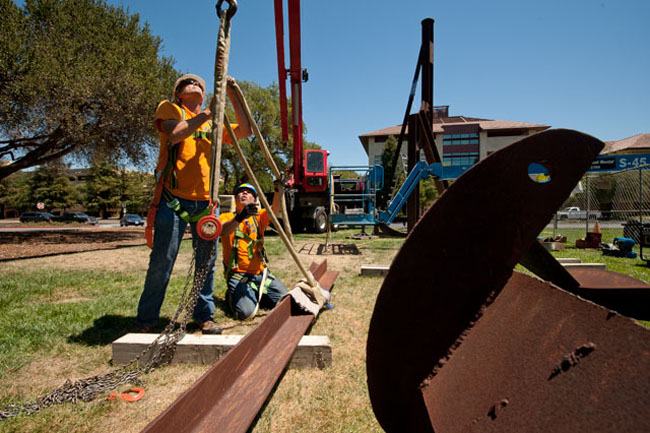
Linda Cicero
Between disassembling and reassembling, Miwok received a thorough but careful cleaning by trained conservators. You can’t just turn a hose on a di Suvero.
The move from one lawn to another was necessary because of the Stanford Medical Center renewal project. Miwok makes out nicely in the deal, as the Dean’s Lawn is highly visible from busy Campus Drive.
Miwok (1981-82), weighing in at 12,500 pounds and standing almost 30 feet tall, was a gift from Rita and Toby Schreiber in 2003. This is its first move since being sited on campus.
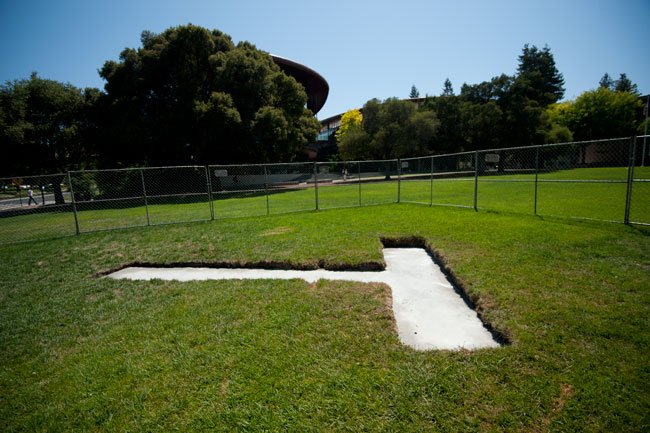
Linda Cicero
Hilarie Faberman, curator of modern and contemporary art at Stanford’s Cantor Arts Center, says of the multi-element Miwok, “With its broad shoulders and totemic form, it has resonance with Native American imagery.”
It took a full day for Atthowe Fine Art Services, a contractor specializing in art handling and moving, to disassemble Miwok. The crew of four used a boom-lift, or cherry picker, to reach the highest bolts, which were removed with a pneumatic drill. Each steel element was carefully wrapped in moving blankets and plastic, fastened with heavy-duty nylon straps, and lifted by a crane before being placed safely on the ground.
A sturdy new concrete foundation was custom-designed by Atthowe not only to support the full weight of the sculpture, but with another relocation in mind.
Although Miwok is not scheduled to move again in the near future, the Cantor staff had Atthowe modify the original foundation and base design, with the artist’s permission, so that the steel elements previously welded to the foundation are instead bolted, making another move less invasive and less complicated.
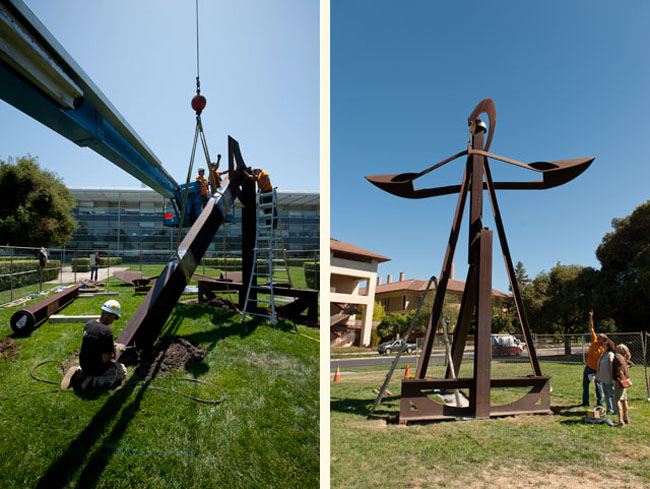
Linda Cicero
Clean up
Birds love a high perch in the middle of a lawn, so cleaning that perch becomes necessary after a while. The conservators took advantage of the sculpture’s disassembled state to clean the hard-to-reach places.
Elizabeth Saetta, the lead outdoor art conservator, said of the project, “Having spent many years in New York’s Central Park battling the birds, cleaning Miwok was familiar, but I have never worked on a single object that is so large before. It has been interesting.”
“In order to make sure the piece looks its best, we didn’t take the cleaning too far, practicing the ethics of art conservation not to remove original material,” said Saetta.
Saetta’s conservative conservations approach to the steel surface was to clean just enough to avoid damaging the protective patina. The color, or patina, of Miwok has developed organically over time – the artist did not chemically apply it. The challenge for Saetta and her team was to remove the bird droppings from the surface without completely exposing the underlying metal.
“In order to make sure the piece looks its best, we didn’t take the cleaning too far, practicing the ethics of art conservation not to remove original material,” said Saetta.
How do you clean a giant steel sculpture that’s been sitting in the ceaseless Stanford sun for nine years? Soap and water – but not your garden variety.
Saetta said that every sculpture on campus is washed with an anionic soap, which is gentle enough for a variety of surfaces and is non-corrosive. She uses soft bristle brushes and, because steel is a heartier material than some other works of art, Saetta was able to use a power washer at low pressure on Miwok.
Areas of compacted, difficult-to-remove bird droppings were poulticed with the same anionic soap and water, which entails soaking cotton rags with the soap/surfactant solution and leaving them on these areas, allowing a longer surface acting time to further soften the resilient bird droppings.
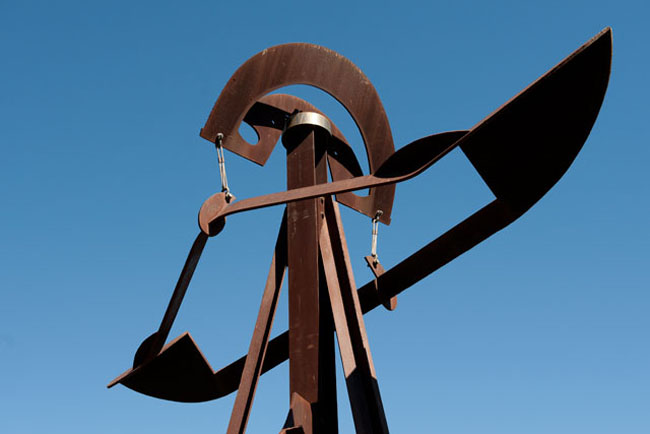
Linda Cicero
The panel
Stanford’s Presidential Panel on Outdoor Art provided guidance on the relocation. The panel is a group made up of faculty, students, community members and Cantor Arts Center staff. The panel was established about 30 years ago.
Ralph S. Greco, a professor of surgery and a sculptor in his own right, is the current chair of the panel, a responsibility he relishes: “I will be stepping down and off the committee in the fall. I will miss it terribly.”
As with all outdoor art sitings, the new location for Miwok was chosen by the panel, guided by Faberman. Two overriding factors that the panel must consider when siting a sculpture are maintenance and preservation.
With maintenance and preservation in mind, irrigation of the surrounding landscape, which can result is unsightly mineral deposits and encourage corrosion, must be considered. The landscape itself can also pose a problem, so the panel tries to site sculptures without trees directly overhead that could deposit sap or pollen on the artwork. And again, the birds are an overhead factor.
Existing underground plumbing and electrical piping must be noted. The physical placement of the sculpture is crucial, given that California is seismically active. Each sculpture’s mount is engineered to make the piece as earthquake-stable as possible.
“In looking for a site, we needed a location that was open and airy and a place that wouldn’t swallow or dwarf the work, or where the sculpture would overpower the surroundings,” said Faberman. “I think the Dean’s Lawn is a particularly good site as Miwok fits in well with the landscape and architecture and the sculpture’s color harmonizes with both. Silhouetted against the sky, the sculpture seems to take on strong anthropomorphic qualities.”
